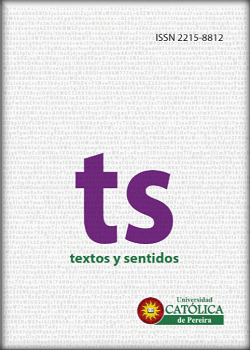Pedagogical narratives: a window towards coexistence
Keywords:
Mapping, Conflict, Coexistence, NarrativeAbstract
This article is the result of a research process carriedout within the macro project “Inclusive pedagogicalnarratives in vulnerable educational contexts”,specifically in the Inmaculada Educational Institution.To collect information, a mapping tool was used inorder to attain the educational context characterizationand identifying the main areas of risk and possibilities,where not only conflict situations occur, but alsopeaceful coexistence expressions among girls arealso manifested. To mitigate the conflict, awarenessworkshops, oral histories, written and photographicstrategies were implemented in order to sensitizedstudents for decision-making in conflict situations,and highlight those positive characteristics thatstrengthen and consolidate the relationship withtheir peers. Theories from authors such as Vygotsky(1977) “internalization”, Bruner (2003) “narrativeand story,” Chaux (2012) “conflict and coexistence”,were addressed as main references. These authors’theoretical reflection allowed us to analyze, explainand argue school conflicts negotiation and resolutionprocess.How do pedagogical narratives evidence conflictsituations occurring between 3ºB students at the Inmaculada Educational Institute in order tostrengthen their peaceful coexistence, was raisedas our research question, so that we could developcitizenship skills such as empathy, assertiveness andmanaging emotions in them. In response to thisquestion, we found out that by doing a strong work incitizenship skills in the classroom, makes it possibleto develop peaceful coexistence environments.Hence, when handling conflict and aggression hasbeen learnt, surely education will be as that of abetter quality
References
Bruner, J. (1991). Actos de significado: Más allá de la revolución cognitiva. Madrid: Alianza.
Chaux, E. (2012). Educación, convivencia y agresión escolar. Bogotá: Uniandes.
Chaux, E., Lleras, J. & Velasquez, A. (2004). Competencias ciudadanas: De los Estándares al Aula. Una propuesta de integración a las áreas académicas. Bogotá: Uniandes.
Habegger, S. & Mancila, I. (2006). El poder de la Cartografía Social en las prácticas contrahegemónicas a la Cartografía Social como estrategia para diagnosticar nuestro territorio. Recuperado de http://www2.fct.unesp.br/docentes/geo/girardi/Cartografia%20PPGG%202015/TEXTO%2027.pdf
Quiñonez, M. (2011). La manera cultural: entre el Desarrollo y la Territorialización, una experiencia de cartografía social en la zona de bajamar – Isla de Cascajal Buenaventura. Entramado vol.7 no.2.
Marquínez, O. P. B. (2013). Estado del arte de la educación virtual en Risaralda: perspectiva cualitativa y cuantitativa en un modelo de investigación mixta. Textos y Sentidos, (7).
Marquínez, O. P. B. (2014). Mutaciones de léxico en los textos escritos del área del pensamiento educativo y la comunicación. Textos y Sentidos, (10).
Siciliani, J.M. (2014). Contar según Jerome Bruner. Itinerario Educativo, XXVIII (63), 31-59.
Vigotsky, L.S. (1977). Pensamiento y lenguaje. Buenos Aires: La Pleyade

